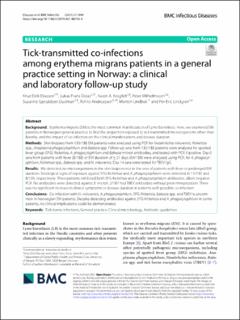| dc.description.abstract | Background Erythema migrans (EM) is the most common manifestation of Lyme borreliosis. Here, we examined EM patients in Norwegian general practice to find the proportion exposed to tick-transmitted microorganisms other than Borrelia, and the impact of co-infection on the clinical manifestations and disease duration. Methods Skin biopsies from 139/188 EM patients were analyzed using PCR for Neoehrlichia mikurensis, Rickettsia spp., Anaplasma phagocytophilum and Babesia spp. Follow-up sera from 135/188 patients were analyzed for spotted fever group (SFG) Rickettsia, A. phagocytophilum and Babesia microti antibodies, and tested with PCR if positive. Day 0 sera from patients with fever (8/188) or EM duration of ≥ 21 days (69/188) were analyzed, using PCR, for A. phagocytophilum, Rickettsia spp., Babesia spp. and N. mikurensis. Day 14 sera were tested for TBEV IgG. Results We detected no microorganisms in the skin biopsies nor in the sera of patients with fever or prolonged EM duration. Serological signs of exposure against SFG Rickettsia and A. phagocytophilum were detected in 11/135 and 8/135, respectively. Three patients exhibited both SFG Rickettsia and A. phagocytophilum antibodies, albeit negative PCR. No antibodies were detected against B. microti. 2/187 had TBEV antibodies without prior immunization. There was no significant increase in clinical symptoms or disease duration in patients with possible co-infection. Conclusions Co-infection with N. mikurensis, A. phagocytophilum, SFG Rickettsia, Babesia spp. and TBEV is uncommon in Norwegian EM patients. Despite detecting antibodies against SFG Rickettsia and A. phagocytophilum in some patients, no clinical implications could be demonstrated. | |
